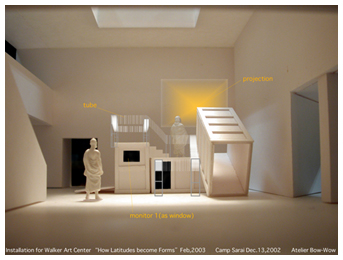


 |
 ††
††
††
††
 ††
††
††
††
launch interview with Yohiharu Tsukamoto
launch conversation with Yoshiharu Tsukamoto and Philippe Vergne
An architectural studio formed in 1992 by Yoshiharu Tsukamoto and Momoyo Kaijima, Atelier Bow-Wow champions a site- and use-specific approach to design for the new millennium. Leaders of a new generation of Tokyo architects, Tsukamoto and Kaijima are proponents of what they have named da-me, or no-good, architecture. Multilayered structures with varied uses (underpass + cinema + bar + barbershop + store, for example), these buildings epitomize a new creative, adaptive aesthetic that is the quintessence of Tokyo. One of their projects, Made in Tokyo, is a book that catalogs seventy such structures and provides a methodology and guide to key works. Reminiscent of the unique categorizing systems of other conceptual artists such as Dan Graham and Hans Haacke, Atelier Bow-Wow's work is both a serious research undertaking and a humorous look at its subject and its project. Another book, the Pet Architecture Guidebook, documents small structures built in response to their usually tiny, throwaway locations in the cityscape. An urban, tongue-in-cheek updating of the idea introduced by Bernard Rudofsky in Architecture without Architects: An Introduction to Non-Pedigreed Architecture, the Pet Architecture Guidebook includes examples such as a wedge-shaped motorcycle shop on a sidewalk/island and small diners that are little more than countertops alongside open kitchens.
In addition to documenting existing structures, Atelier Bow-Wow has submitted its own design proposals, including an outdoor bath that takes advantage of the underutilized space atop a large incinerator smokestack and a Manga Pod. The Manga Pod is a structure for relaxation that was installed at the 2002 Gwangju Biennale, South Korea. Made of recycled manga comic books and a flexible shelving structure, its rotating joints flex to adapt to the movement of its users, exemplifying Atelier Bow-Wow's commitment to a new design aesthetic dictated by utility and context.
For How Latitudes Become Forms, Atelier Bow-Wow has collaborated with Raqs Media Collective to design Architecture for Temporary Autonomous Sarai for the presentation of online projects by Raqs and other artists. In addition to the 2002 Gwangju Biennale, Atelier Bow-Wow has participated in the Second Fukuoka Asian Art Triennale, Japan (2002), and in exhibitions in Germany, The Netherlands, Paris, and London.
--Aimee Chang











